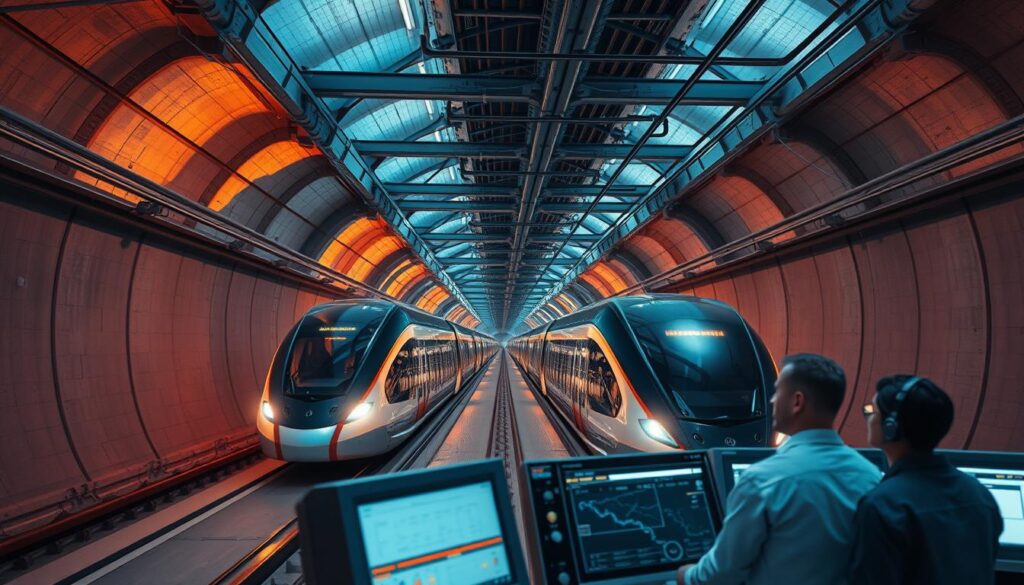As cities continue to grow and urbanization increases, the need for efficient tunnel transportation design has become more pressing. Can innovative solutions in this field help meet the demands of modern transportation infrastructure planning?
The importance of tunnel transportation design cannot be overstated, as it plays a critical role in reducing congestion and improving connectivity. By incorporating smart technologies and sustainable practices, as discussed in our article on tunnel construction, we can create more efficient and environmentally friendly transportation systems.
Key Takeaways
- Innovative tunnel transportation design is crucial for modern infrastructure.
- Smart technologies can significantly enhance transportation efficiency.
- Sustainable practices are key to environmentally friendly tunnel design.
- Effective transportation infrastructure planning is vital for urban development.
- Tunnel construction projects can benefit from advanced engineering solutions.
Understanding Tunnel Transportation Design
Tunnel transportation design involves a multifaceted approach, combining engineering expertise with environmental considerations. It is a crucial aspect of modern urban planning, aimed at enhancing the efficiency and safety of transportation systems.
Definition and Importance
Tunnel transportation design refers to the process of planning, designing, and constructing tunnels for various transportation modes, including roads, railways, and pedestrian paths. The importance of tunnel transportation design lies in its ability to alleviate surface congestion, reduce travel times, and improve air quality in urban areas. For a deeper understanding of tunnel engineering and its applications, visit this resource.
The design process involves a comprehensive analysis of geological, environmental, and social factors to ensure that the tunnel is safe, durable, and meets the needs of the community.
Historical Context
The history of tunnel construction dates back thousands of years, with early examples found in ancient civilizations. Modern tunnel transportation design has evolved significantly, incorporating advanced technologies and materials to address the complex challenges of contemporary urban environments.
Historically, tunnel construction was limited by technological capabilities and often involved significant manual labor. Today, the field has advanced to include sophisticated tunnel construction engineering techniques, enhancing the speed, safety, and quality of tunnel projects.
Key Applications
Tunnel transportation design has various key applications in urban areas, including:
- Reducing traffic congestion through the creation of underground road networks.
- Enhancing public transportation systems with dedicated rail tunnels.
- Improving pedestrian and cyclist infrastructure with safe, underground pathways.
These applications highlight the versatility and importance of urban tunnel design in creating more livable, sustainable cities.
Planning and Feasibility Studies
Tunnel transportation design requires meticulous planning and feasibility studies to ensure project viability. Effective planning involves a comprehensive analysis of various factors that influence the success of tunnel transportation projects.
Site Assessment Techniques
Site assessment is a critical component of the planning phase. It involves evaluating the geological, hydrological, and environmental conditions of the proposed tunnel site. Advanced technologies such as geophysical surveys and geotechnical drilling are employed to gather data on soil composition, rock stability, and groundwater levels.
The data collected during site assessment helps engineers to identify potential risks and develop strategies to mitigate them. For instance, understanding the soil composition is crucial for designing the tunnel’s lining and ensuring its structural integrity.
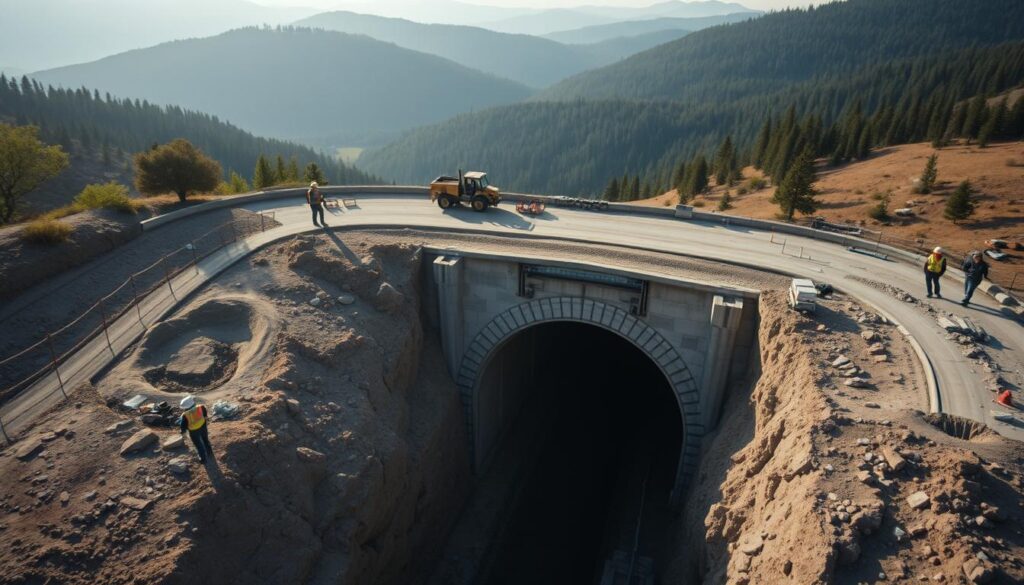
Cost-Benefit Analysis
A thorough cost-benefit analysis is essential for determining the feasibility of a tunnel transportation project. This involves estimating the total costs, including construction, maintenance, and operational expenses, and comparing them with the anticipated benefits, such as reduced travel times and increased economic activity.
By conducting a detailed cost-benefit analysis, stakeholders can make informed decisions about whether to proceed with a project. It also helps in identifying areas where costs can be optimized without compromising the project’s objectives.
Environmental Considerations
Environmental considerations play a significant role in the planning and feasibility studies of tunnel transportation projects. It is crucial to assess the potential environmental impacts, such as disruption to ecosystems, noise pollution, and effects on local communities.
Strategies to mitigate these impacts include implementing sustainable construction practices and designing tunnels with features that minimize environmental disturbance. For example, using tunnel boring machines (TBMs) can reduce the surface impact compared to traditional cut-and-cover methods.
By carefully considering these factors, planners and engineers can develop tunnel transportation projects that are not only feasible but also environmentally responsible and sustainable in the long term.
Design Considerations in Tunnel Transportation
The design of tunnels for transportation is a multifaceted task that requires careful planning and execution. Transportation tunnel safety is paramount, and it starts with thoughtful design considerations.
Structural Integrity
Ensuring the structural integrity of a tunnel is fundamental to its design. This involves selecting appropriate materials and construction techniques that can withstand geological stresses and other external factors.
Tunnel construction engineering plays a crucial role in this aspect, as it involves detailed analysis and simulation to predict how the tunnel will behave under various conditions.
Safety Features
Safety features are a critical component of tunnel design. These include emergency exit strategies, fire suppression systems, and advanced ventilation systems to maintain air quality.
The incorporation of intelligent safety systems can significantly enhance the safety of tunnel users by providing real-time monitoring and response capabilities.
Aesthetic Elements
While functionality and safety are paramount, the aesthetic appeal of tunnels should not be overlooked. Aesthetic elements can enhance the user experience, making the tunnel more welcoming and less daunting for travelers.
This can involve architectural design elements, lighting, and even public art installations within the tunnel.
In conclusion, the design of tunnels for transportation involves a delicate balance between structural integrity, safety features, and aesthetic elements. By carefully considering these factors, engineers can create tunnels that are not only safe and functional but also pleasing to users.
Technologies in Tunnel Design
The integration of advanced technologies has revolutionized tunnel design, enhancing both functionality and safety. Modern tunnel projects now heavily rely on sophisticated tools and systems to ensure efficient construction and operation.
Tunnel design has become increasingly complex, requiring precise planning and execution. Advanced Simulation Software plays a crucial role in this process, allowing engineers to model various scenarios and predict potential issues.
Advanced Simulation Software
Advanced simulation software enables the creation of detailed models of tunnel environments, including ventilation and lighting systems. This software helps in optimizing tunnel ventilation design by simulating airflow and temperature distributions, ensuring a safe and healthy environment for users.
For instance, software like ANSYS or OpenFOAM can be used to simulate complex fluid dynamics and thermal analysis, crucial for designing effective ventilation systems.

Geotechnical Tools
Geotechnical Tools are essential for assessing the geological conditions surrounding a tunnel. These tools help in predicting ground behavior, identifying potential hazards, and designing appropriate support structures.
Techniques such as Ground-Penetrating Radar (GPR) and Electrical Resistivity Tomography (ERT) provide valuable data on subsurface conditions, aiding in the design of stable tunnels.
| Geotechnical Tool | Application | Benefit |
|---|---|---|
| GPR | Subsurface imaging | Identifies hidden hazards |
| ERT | Subsurface resistivity mapping | Aids in geological characterization |
Automated Monitoring Systems
Automated Monitoring Systems are vital for ensuring the ongoing safety and integrity of tunnels. These systems continuously monitor parameters such as structural deformation, temperature, and air quality.
For tunnel lighting design, automated monitoring systems can adjust lighting levels based on real-time data, optimizing energy use and enhancing user experience.
By leveraging these technologies, tunnel designers and operators can significantly improve the safety, efficiency, and sustainability of tunnel projects.
Types of Tunnels for Transportation
The design and implementation of tunnels for transportation vary significantly based on their intended use. Urban tunnel design requires a deep understanding of the specific needs of different transportation modes.
Road Tunnels
Road tunnels are a critical component of urban infrastructure, allowing for the efficient movement of vehicular traffic. They are particularly useful in densely populated areas where surface traffic congestion is a significant issue. The design of road tunnels involves considerations such as ventilation systems, lighting, and safety features like emergency exits and fire suppression systems.
Rail Tunnels
Rail tunnels are designed to accommodate railway lines, providing a fast and efficient mode of transportation. These tunnels are often deeper and longer than road tunnels, requiring advanced engineering techniques for their construction. The design of rail tunnels must consider factors such as train speed, electrification, and signaling systems.
Pedestrian Tunnels
Pedestrian tunnels enhance connectivity in urban areas by providing safe passage for walkers. They are particularly important near highways or in areas with heavy vehicular traffic. The design of pedestrian tunnels focuses on safety, accessibility, and aesthetics, often incorporating elements like lighting and security surveillance.
For more detailed information on tunnel design and construction, visit Structure Magazine.
| Tunnel Type | Primary Use | Key Design Considerations |
|---|---|---|
| Road Tunnels | Vehicular Traffic | Ventilation, Lighting, Safety Features |
| Rail Tunnels | Railway Lines | Train Speed, Electrification, Signaling |
| Pedestrian Tunnels | Pedestrian Passage | Safety, Accessibility, Aesthetics |
Environmental Impact of Tunnels
The construction and operation of tunnels have significant environmental implications that must be carefully managed to minimize ecological disturbances. Tunnels can affect local ecosystems, disrupt natural habitats, and impact air and water quality. Effective environmental considerations are crucial to mitigate these effects.
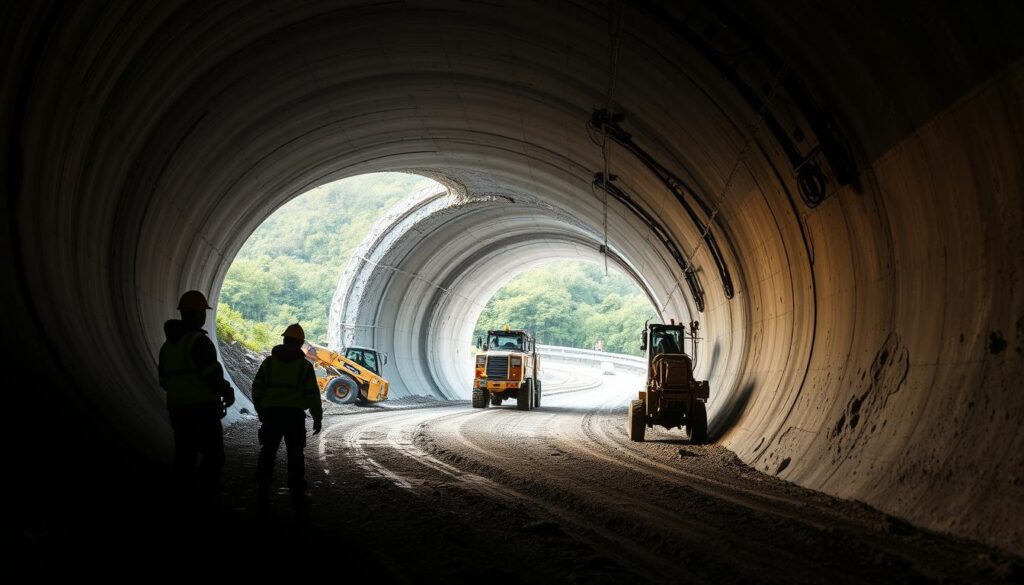
Mitigating Ecological Disturbances
Mitigating ecological disturbances is a critical aspect of tunnel design and operation. This involves implementing tunnel traffic management strategies to reduce congestion and minimize the environmental footprint. By optimizing traffic flow, tunnels can reduce emissions and lower the overall environmental impact.
Ecological disturbances can be mitigated through careful planning and the use of advanced technologies. For instance, environmental impact assessments can identify potential risks, allowing for the development of targeted mitigation strategies. These might include habitat restoration, wildlife corridors, and measures to reduce noise and air pollution.
Noise Reduction Strategies
Noise reduction is another critical environmental consideration in tunnel design. Tunnels can generate significant noise pollution, affecting both local communities and wildlife. To address this, various noise reduction strategies can be employed, including the use of sound-absorbing materials, noise barriers, and optimized tunnel ventilation systems.
Effective noise reduction strategies not only improve the quality of life for nearby residents but also contribute to a healthier environment for local wildlife. By incorporating noise mitigation measures into tunnel design, the overall environmental impact can be significantly reduced.
In conclusion, the environmental impact of tunnels can be substantial, but through careful planning, innovative design, and effective management, these impacts can be minimized. By prioritizing environmental considerations and implementing strategies to mitigate ecological disturbances and reduce noise pollution, tunnel projects can achieve a more sustainable and environmentally friendly outcome.
Case Studies of Successful Tunnel Projects
Examining case studies of prominent tunnel projects reveals innovative solutions and designs that have reshaped modern transportation. These projects not only demonstrate engineering prowess but also highlight the importance of tunnel transportation design in enhancing urban mobility.
Boston’s Big Dig
Boston’s Big Dig is one of the most ambitious tunnel transportation design projects in the United States. This massive undertaking involved rerouting the city’s main highway underground, significantly reducing traffic congestion and revitalizing the city’s waterfront area. The project’s success was largely due to its comprehensive transportation infrastructure planning, which integrated road, rail, and pedestrian pathways.
The Gotthard Base Tunnel
The Gotthard Base Tunnel in Switzerland is another exemplary case of successful tunnel construction. As the longest rail tunnel in the world, it has transformed European rail travel by reducing travel times between Zurich and Milan. The tunnel’s design and construction required cutting-edge technology and meticulous planning, showcasing the importance of innovative transportation infrastructure planning.
Los Angeles’ Purple Line Extension
Los Angeles’ Purple Line Extension is a significant tunnel transportation design project that aims to enhance the city’s subway system. By extending the Purple Line, the project will improve connectivity between different parts of the city, reduce surface traffic, and promote more sustainable urban transportation. The project’s success will depend on effective transportation infrastructure planning and execution.
These case studies demonstrate that successful tunnel projects require a combination of innovative design, careful planning, and effective execution. By studying these examples, urban planners and engineers can gain valuable insights into best practices for tunnel transportation design and transportation infrastructure planning.
Challenges in Tunnel Transportation Design
Tunnel transportation design faces a multitude of obstacles that require innovative solutions. The complexity of tunnel construction engineering is multifaceted, involving technical, financial, and regulatory challenges.
One of the primary concerns in tunnel transportation design is addressing geological and hydrological issues. The stability of the tunnel is heavily dependent on the geological conditions of the area it is being constructed in. Unforeseen geological issues can lead to significant delays and cost overruns.
Geological and Hydrological Issues
Geological and hydrological issues are a major challenge in tunnel construction. For instance, tunnels constructed in areas with high water tables or unstable rock formations require specialized engineering solutions to ensure stability and safety.
A transportation engineer plays a crucial role in assessing these conditions and devising strategies to mitigate potential risks.
| Geological Condition | Challenge | Solution |
|---|---|---|
| High Water Table | Water ingress and tunnel stability | Advanced drainage systems and waterproofing |
| Unstable Rock Formations | Rockfalls and tunnel collapse | Rock reinforcement and support systems |
Budget Constraints
Budget constraints are another significant challenge in tunnel transportation design. The high costs associated with tunnel construction, including materials, labor, and technology, can be a substantial burden.
Efficient project management and cost-effective solutions are essential to delivering tunnel projects within budget. This includes optimizing design elements and leveraging technology to reduce costs.
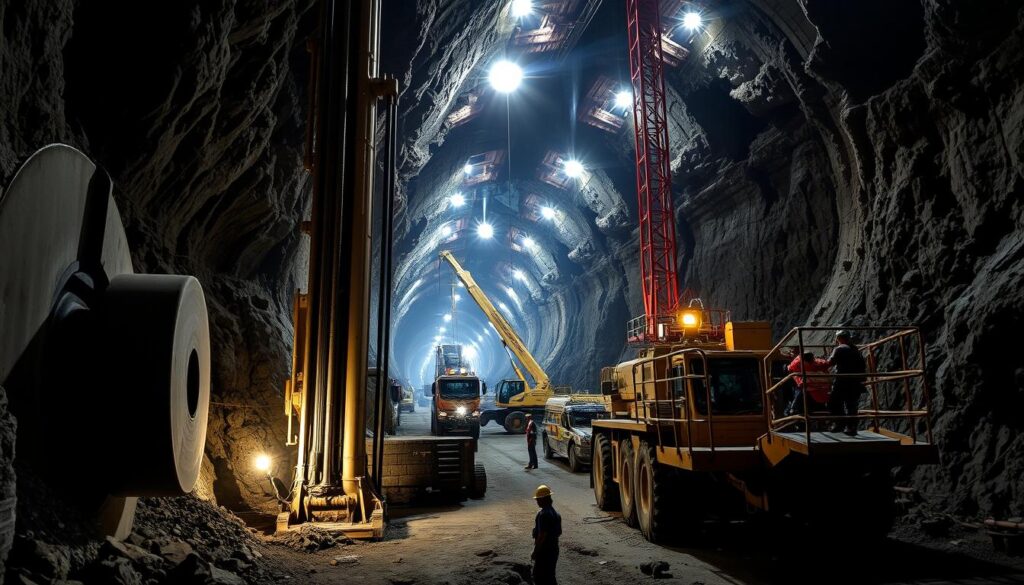
Regulatory Hurdles
Regulatory hurdles also pose a challenge in urban tunnel design. Compliance with environmental regulations, safety standards, and local building codes is mandatory.
Understanding and navigating these regulatory requirements is crucial to avoiding project delays and ensuring that the tunnel is constructed to the required standards.
In conclusion, the challenges in tunnel transportation design are diverse and complex, requiring a comprehensive and integrated approach to overcome. By understanding these challenges and leveraging innovative solutions, it is possible to deliver successful tunnel projects that meet the needs of modern transportation systems.
Innovations in Tunnel Construction
Tunnel construction is evolving with advancements in prefabrication, ventilation, and sustainable materials. The industry is shifting towards more efficient, safe, and environmentally friendly practices.
Use of Prefabricated Elements
The use of prefabricated elements in tunnel construction is gaining popularity due to its potential to reduce construction time and improve quality. Prefabricated tunnel segments are manufactured in a controlled environment, ensuring higher precision and durability.
According to a report on innovations in tunnel design, the adoption of prefabricated elements can significantly cut down on-site labor costs and minimize environmental disruption.
Ventilation and Air Quality Improvements
Effective ventilation is crucial in tunnel construction to ensure a safe working environment and to maintain air quality for users. Innovations in tunnel ventilation design have led to more efficient systems that reduce energy consumption and improve air quality.
Advanced ventilation systems utilize sophisticated sensors and real-time data to optimize airflow and minimize pollutants. This not only enhances the safety of the tunnel but also contributes to a more sustainable operation.
Sustainable Material Use
The incorporation of sustainable materials in tunnel construction is becoming increasingly important as the industry moves towards more environmentally friendly practices. Sustainable materials reduce the environmental footprint of tunnel projects and can offer long-term cost savings.
For instance, the use of recycled materials in tunnel lining and the application of low-carbon concrete are practices that are being adopted in modern tunnel construction. As highlighted in a guide on cutting construction costs, sustainable material use can also contribute to cost efficiency.
| Innovation | Benefits | Examples |
|---|---|---|
| Prefabricated Elements | Reduced construction time, improved quality | Precast tunnel segments |
| Ventilation Improvements | Enhanced air quality, energy efficiency | Advanced ventilation systems with real-time monitoring |
| Sustainable Materials | Reduced environmental impact, cost savings | Recycled materials, low-carbon concrete |
These innovations are transforming the tunnel construction industry, making it more efficient, safe, and sustainable. As the industry continues to evolve, we can expect to see further advancements in these areas.
Maintenance and Monitoring
Effective maintenance and monitoring are crucial for ensuring the safety and efficiency of tunnel transportation systems. Regular checks and advanced technologies work together to prevent potential issues and ensure smooth operation.
Regular Inspection Protocols
Regular inspection protocols are the backbone of tunnel maintenance. These protocols involve thorough checks of the tunnel structure, including the lining, road surface, and ventilation systems. Inspections can be scheduled based on traffic volume, age of the tunnel, and environmental conditions. For instance, tunnels with high traffic volumes may require more frequent inspections.
Key components of regular inspection protocols include:
- Visual inspections by trained personnel
- Use of advanced technologies like ground-penetrating radar
- Monitoring of structural elements for signs of wear or damage
By identifying potential issues early, maintenance teams can address problems before they become major concerns, thereby enhancing tunnel transportation safety.
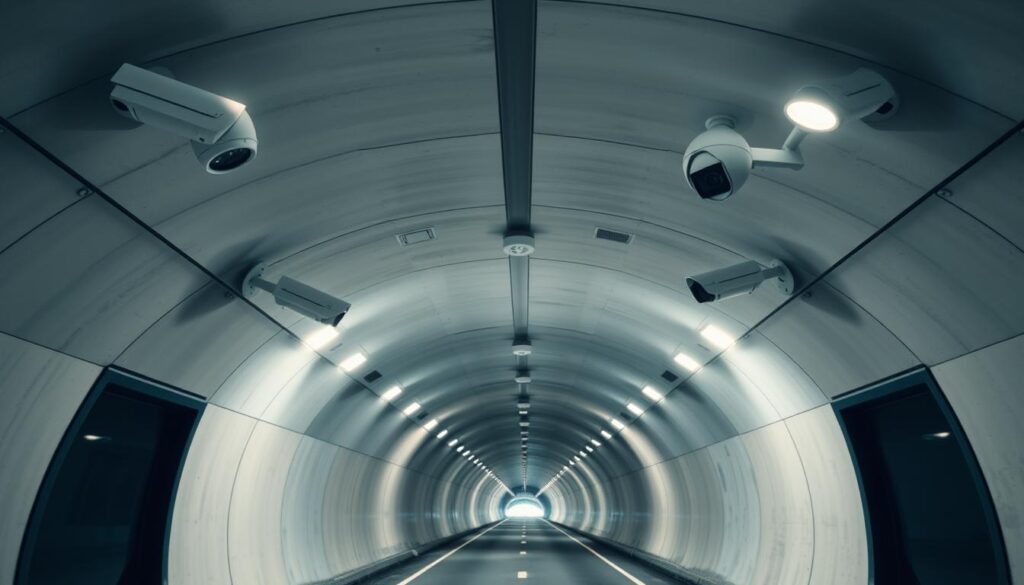
Innovative Maintenance Technologies
Innovative maintenance technologies are revolutionizing the way tunnels are maintained. One such technology is the use of wireless sensor networks for real-time monitoring of tunnel conditions. These systems can detect changes in temperature, humidity, and structural integrity, allowing for prompt action. For more information on tunnel monitoring systems, visit Resensys tunnel monitoring page.
Some of the benefits of innovative maintenance technologies include:
- Reduced need for manual inspections, improving safety for maintenance personnel
- Real-time data analysis for proactive maintenance
- Enhanced efficiency through automated reporting and alerts
By leveraging these technologies, tunnel operators can implement effective tunnel traffic management strategies, minimizing disruptions and ensuring a smoother travel experience.
Future Trends in Tunnel Transportation
As we look ahead, tunnel transportation is on the cusp of a transformation driven by smart technologies and sustainability. The integration of innovative solutions is set to enhance the efficiency, safety, and environmental footprint of tunnel projects.
The concept of smart tunnels is gaining traction, leveraging IoT applications to create more efficient and responsive tunnel systems. This includes advanced monitoring systems that can detect and respond to changes in tunnel conditions in real-time.
Smart Tunnels and IoT Applications
Smart tunnels utilize a range of technologies, including sensors and data analytics, to optimize tunnel operations. For instance, intelligent tunnel lighting design can adjust based on traffic conditions, reducing energy consumption and enhancing safety.
The use of IoT devices allows for real-time monitoring of tunnel conditions, enabling proactive maintenance and reducing the risk of accidents. This technology can also be used to optimize traffic flow, minimizing congestion and reducing travel times.
Green Technologies in Tunnel Design
In addition to smart technologies, the adoption of green technologies is becoming increasingly important in tunnel design. This includes the use of sustainable materials, energy-efficient systems, and innovative ventilation designs that reduce environmental impact.
Green technologies not only contribute to a more sustainable tunnel infrastructure but also enhance the overall user experience. For example, advanced ventilation systems can improve air quality, creating a healthier environment for travelers.
As the tunnel transportation sector continues to evolve, the integration of smart and green technologies will play a crucial role in shaping the future of tunnel design and operation.
The Role of Public Involvement
Community engagement is essential for the successful implementation of urban tunnel design projects. It ensures that the needs and concerns of the local population are taken into account, fostering a sense of ownership and cooperation.
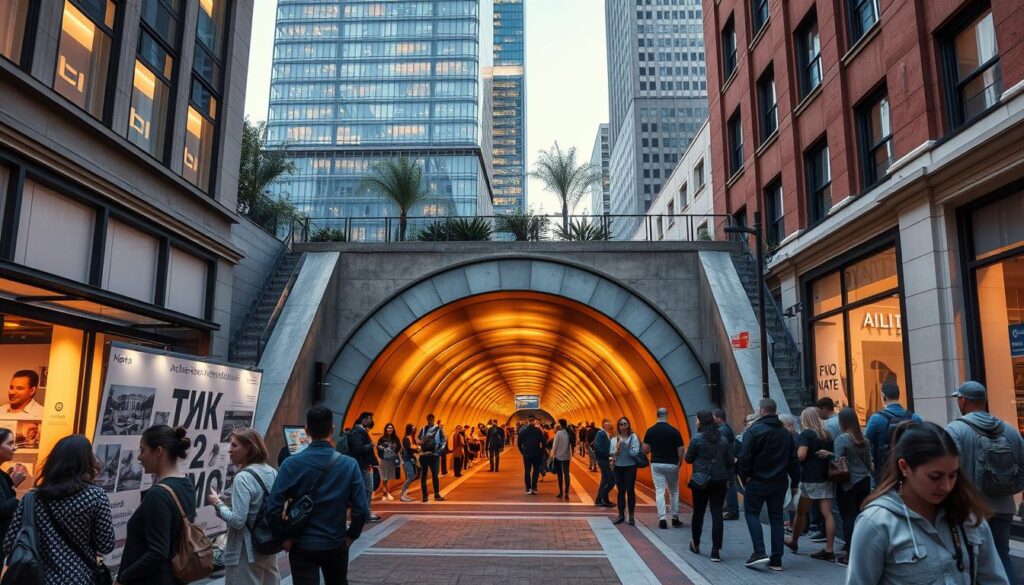
Community Engagement Strategies
Effective community engagement involves several key strategies. These include public meetings, surveys, and the use of digital platforms to gather feedback and keep the community informed about project developments.
- Public meetings to discuss project plans and gather feedback
- Surveys to understand community needs and concerns
- Digital platforms for continuous updates and feedback
Addressing Public Concerns
Addressing public concerns is crucial for maintaining trust and support throughout the project. This involves transparent communication about the project’s benefits, potential impacts, and mitigation measures.
By engaging with the community and addressing their concerns, project developers can create a more collaborative and successful tunnel transportation project.
Conclusion and Future Outlook
Tunnel transportation design is undergoing a significant transformation, driven by innovative solutions and technological advancements. As seen in various projects, such as the Gotthard Base Tunnel and the Hyperloop system, tunnel transportation can significantly reduce travel time and environmental impact.
The future outlook for tunnel transportation design is promising, with the potential to travel at speeds of up to 700 mph. Systems like the Hyperloop are designed to be powered by renewable energy sources, making them an environmentally friendly option.
Innovative Solutions and Evolution
The evolution of tunnel transportation design will be shaped by continued innovation and investment in infrastructure. As new technologies emerge, we can expect to see even more efficient and sustainable tunnel transportation systems.
Shaping the Future
The future of tunnel transportation design holds much promise, with the potential to transform the way we travel and transport goods. By embracing innovative solutions and sustainable practices, we can create a more efficient and environmentally friendly transportation network.
